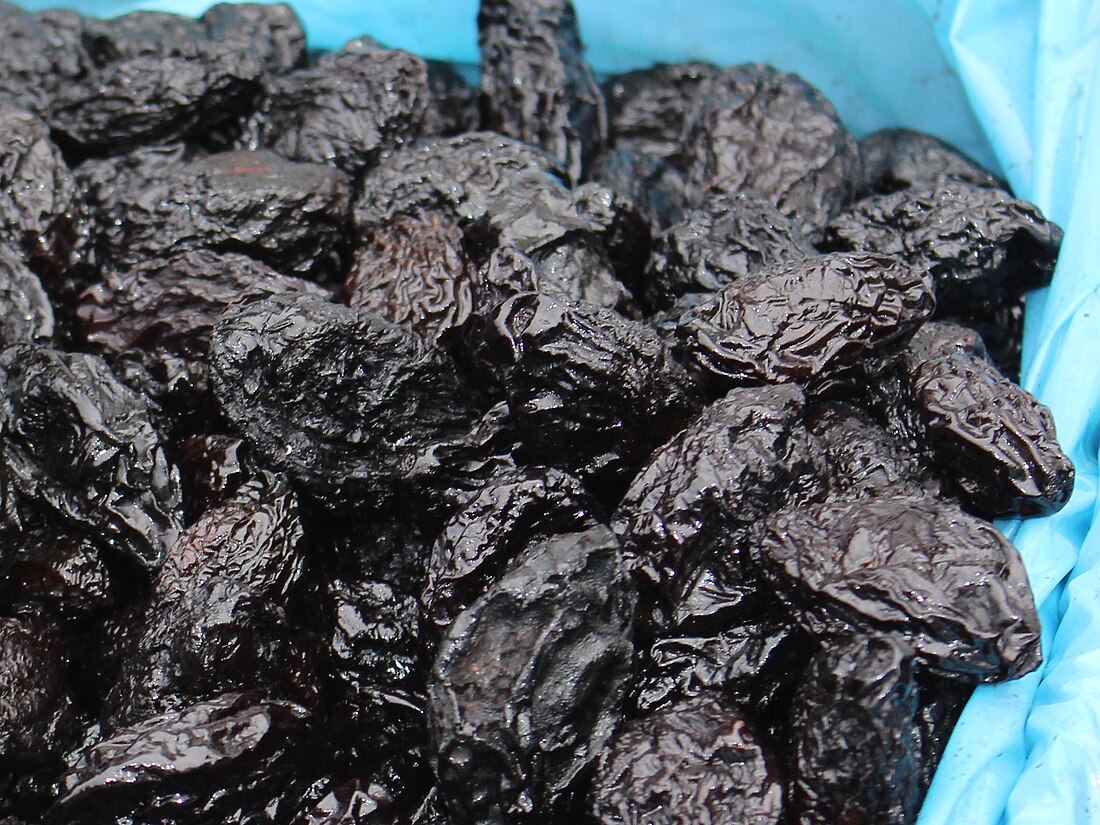Top Qs
Timeline
Chat
Perspective
Prune
Dried plum From Wikipedia, the free encyclopedia
Remove ads
A prune is a dried plum, most commonly from the European plum (Prunus domestica) tree. Not all plum species or varieties can be dried into prunes.[1] Use of the term prune for fresh plums is obsolete except when applied to varieties of plum grown for drying.[2] In this usage, a prune is the firm-fleshed plum fruit of P. domestica varieties that have a high soluble solids content, and do not ferment during drying.[3]

Most prunes are freestone cultivars (i.e., the pit is easy to remove), whereas most plums grown for fresh consumption are clingstone (the pit is more difficult to remove). The sorbitol content of dietary fiber likely provides the laxative effect associated with consuming prunes. Prunes are 64% carbohydrates, including dietary fiber, 2% protein, a rich source of vitamin K, and a moderate source of B vitamins and dietary minerals.
Remove ads
Production
More than 1,000 plum cultivars are grown for drying. The main cultivar grown in the United States is the 'Improved French' prune. Other varieties include 'Sutter', 'Tulare Giant', 'Moyer', 'Imperial', 'Italian', and greengages. Fresh prunes reach the market earlier than fresh plums and are usually smaller in size. The great majority of commercially grown prune varieties are self-fertile and do not need separate pollinator trees.[4]
Name change
In 2001, plum growers in the United States were authorized by the Food and Drug Administration to call prunes "dried plums".[5] Due to a perception that prunes relieve constipation (perceived as derogatory), some distributors stopped using the word "prune" on packaging labels in favor of "dried plums".[6]
Remove ads
Health effects
Summarize
Perspective
Prunes contain dietary fiber (about 7% of weight) which may provide laxative effects,[9] but prune juice also has a laxative effect without containing fiber.[10] Their sorbitol content may also be responsible for this, a conclusion reached in a 2012 review by the European Food Safety Authority.[11] The report also demonstrated that prunes effectively contribute to the maintenance of normal bowel function in the general population if consumed in quantities of at least 100 grams (3.5 oz) per day.[11] Neochlorogenic acid and chlorogenic acid may also contribute to the laxative effect.[10]
Nutrition
Prunes are 31% water, 64% carbohydrates, 2% protein, and less than 1% fat (table). In a reference amount of 100 g (3.5 oz), prunes supply 240 calories, 7 grams of dietary fiber, and are a rich source of vitamin K (50% of the Daily Value, DV), copper (31% DV), and potassium (24% DV), with several B vitamins (12-14% DV) and other dietary minerals in moderate content (10–13% DV) (table).
Phytochemicals
Prunes and prune juice contain phytochemicals, including phenolic compounds (mainly as neochlorogenic acids and chlorogenic acids) and sorbitol.[9]
Remove ads
Uses
Prunes are used in preparing both sweet and savory dishes.[11]
Contrary to the name, boiled plums or prunes are not used to make sugar plums, which instead may be nuts, seeds, or spices coated with hard sugar, also called comfits.[12]
Gallery
- Raw plums that have not been dried into prunes
- Prunes in chocolate with an almond in the middle
See also
- List of dried foods
- List of plum dishes
- Pomology – Study of fruits and their cultivation
- Li hing mui
References
Wikiwand - on
Seamless Wikipedia browsing. On steroids.
Remove ads



